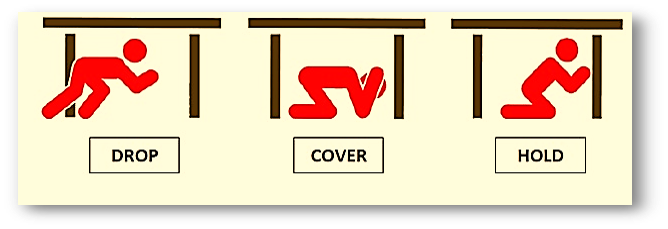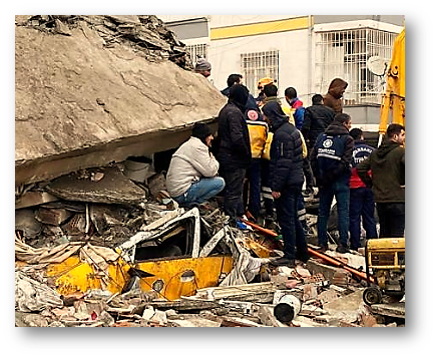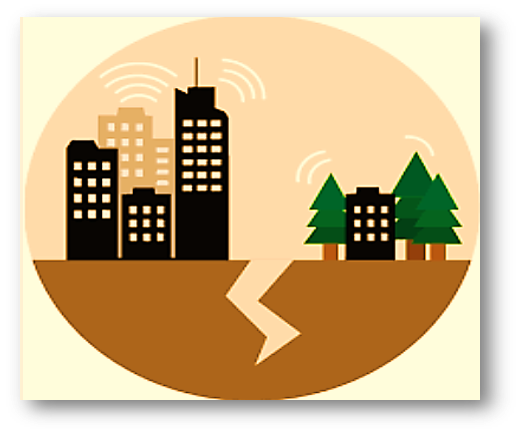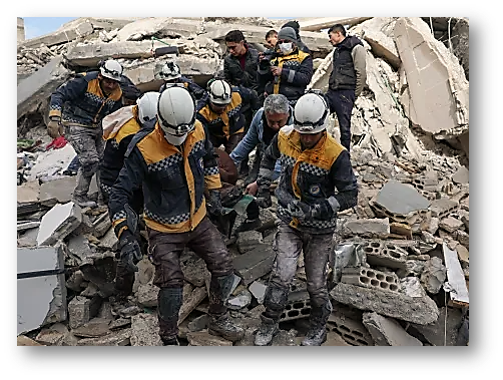Earthquake prediction is the process of estimating the likelihood of an earthquake occurring in a specific geographic area and time. Despite significant advancements in seismology and the understanding of earthquake physics. It is currently not possible to predict earthquakes with certainty.
SOP stands for Standard Operating Procedure. In the context of earthquakes, Standard Operating Procedures (SOPs) refer to a set of guidelines and procedures. That outline the steps to be taken in the event of an earthquake. These procedures are designed to ensure the safety of individuals and the protection of property during and after an earthquake.
Some common SOPs for earthquakes include:

Drop, Cover, and Hold On:
This is the recommended action to take during an earthquake. Individuals should drop to the ground, take cover under a desk or table, and hold on to it until the shaking stops.
Evacuation procedures:
If the building is not safe, individuals should evacuate as quickly and safely as possible.
Communication protocols:
It is important to establish clear communication protocols in the event of an earthquake to ensure that everyone is aware of the situation and can act accordingly.
Building inspections:
Buildings should be inspected after an earthquake to assess the damage and ensure that they are safe for occupancy.
Emergency response plans:
It is important to have an emergency response plan in place that outlines the steps to be taken in the event of an earthquake. Including evacuation procedures, communication protocols, and building inspections.
These are just a few examples of Standard Operating Procedures for earthquakes. The specific procedures will vary depending on the location, type of building, and the potential hazards involved.
WORLD EARTHQUAKE PROTECTION AGENCIES!!

There are several organizations and agencies around the world that work towards earthquake protection and disaster response. Some of the prominent ones include:
United States Geological Survey (USGS):
The USGS is a scientific organization that monitors earthquakes. Volcanic activity, and other geological hazards in the United States and around the world.
Pacific Tsunami Warning Center (PTWC):
The PTWC is a division of the National Oceanic and Atmospheric Administration (NOAA). That is responsible for issuing tsunami warnings for the Pacific Ocean.
United Nations Office for Disaster Risk Reduction (UNDRR):
The UNDRR is a global organization that works towards reducing the risk of disasters. Including earthquakes, and improving the response to them.
International Seismological Centre (ISC):
The ISC is an international organization that collects and analyzes seismic data from around the world. To improve the understanding of earthquakes and the hazards they pose.
World Health Organization (WHO):
The WHO is a global health organization that works to improve the health and well-being of people around the world, including in the aftermath of earthquakes and other disasters.
Red Cross and Red Crescent Societies:
The Red Cross and Red Crescent Societies are international humanitarian organizations that respond to disasters, including earthquakes, and provide aid and support to those affected.
These are some of the major organizations and agencies that work towards earthquake protection and disaster response. The specific organizations involved in earthquake protection will depend on the location and the nature of the earthquake.
WHAT DO YOU DO WHEN AN EARTHQUAKE IS PREDICTED??
When an earthquake is predicted, there are several steps that individuals can take to prepare for and respond to the event. Here are some of the key actions you can take:
Create a disaster plan:
Create a plan for how you and your family will respond to an earthquake. This should include an evacuation plan, a designated meeting place, and a plan for how you will communicate with each other in the event of an earthquake.
Secure your home:
Take steps to secure your home, such as anchoring heavy furniture and appliances to the wall, and placing breakable items on low shelves.
Stock up on emergency supplies:
Make sure you have an emergency supply kit that includes enough food, water, and medical supplies to last for several days.
Practice “Drop, Cover, and Hold On”:
Familiarize yourself with the recommended response to an earthquake, which is to “Drop, Cover, and Hold On.” This means dropping to the ground, taking cover under a desk or table, and holding on to it until the shaking stops.
Turn off gas valves:
If you smell gas or suspect a gas leak, turn off the main gas valve and evacuate the building immediately.
Stay informed:
Stay informed about the latest developments related to the earthquake, including updates on its intensity and any evacuation orders.
Follow official instructions:
Follow any instructions from local authorities and emergency responders, including evacuation orders.
These are just a few examples of what you can do when an earthquake is predicted. The specific actions you should take will depend on the location and the severity of the earthquake. By being prepared and knowing what to do, you can help ensure your safety during and after an earthquake.
RISKS OF EARTHQUAKE PREDICTION!!

Earthquakes can occur anywhere in the world, but certain areas are at a higher risk due to their location and geology. Some of the regions with the highest risk of earthquakes include:
The Ring of Fire:
The “Ring of Fire” is a region around the Pacific Ocean that is characterized by its high level of seismic activity. It includes countries such as Japan, Indonesia, the Philippines, and the western coast of North and South America.
The Mediterranean region:
This region, which includes countries such as Greece, Turkey, and Italy, is prone to earthquakes due to the collision of the African and Eurasian tectonic plates.
Alaska:
Alaska is located on the boundary of the Pacific and North American tectonic plates, making it one of the most seismically active regions in the world.
The Himalayan region:
The Himalayan region, which includes countries such as Nepal, India, and Bhutan, is at high risk of earthquakes due to the collision of the Indian and Eurasian tectonic plates.
California:
California is located on the boundary of the Pacific and North American tectonic plates and is one of the most seismically active regions in the United States.
These are some of the regions with the highest risk of earthquakes, but it’s important to note that earthquakes can occur anywhere, at any time. It’s important to be prepared and know what to do in the event of an earthquake, regardless of where you live.
EARTHQUAKE PROTECTION PLANS ON THE COUNTRY LEVEL!!
Each country has its own earthquake protection plan that outlines its approach to reducing the risks associated with earthquakes and responding to earthquakes when they occur. These plans typically include the following components:
Risk assessment and mapping:
This involves identifying areas that are at high risk of earthquakes and mapping the potential impact of earthquakes in those areas.
Building codes and standards:
Building codes and standards are established to ensure that buildings are constructed in a way that will help them withstand earthquakes.
Public education and awareness:
This involves educating the public about the risks associated with earthquakes and how to prepare for and respond to earthquakes.
Emergency response planning:
Emergency response planning involves developing and rehearsing plans for responding to earthquakes, including evacuation plans and procedures for providing aid and assistance to those affected.
Infrastructure development:
Infrastructure development involves investing in infrastructure that is designed to withstand earthquakes, such as bridges, roads, and utility systems.
Research and development:
Research and development focus on improving the understanding of earthquakes and developing new technologies and techniques for reducing the risks associated with earthquakes.
These are some of the components that are typically included in a country’s earthquake protection plan. The specific components will depend on the country’s risk profile, resources, and priorities. By having a comprehensive earthquake protection plan, a country can better prepare for and respond to earthquakes, reducing the impact of these events on its people and infrastructure.
RISK ASSESSMENT OF EARTHQUAKE WHEN PREDICTED!!
Risk assessment is an important step in preparing for and responding to earthquakes. When an earthquake is predicted, the following steps can be taken to assess the risk:
Determine the magnitude and location of the earthquake:
This information will help to assess the potential impact of the earthquake on the surrounding area.
Evaluate the impact on infrastructure:
Infrastructure such as roads, bridges, and buildings will be evaluated for potential damage and the impact on the surrounding area.
Assess the risk to people:
The risk to people will be evaluated based on factors such as population density, the presence of vulnerable populations, and the proximity of people to the earthquake’s epicenter.
Consider the potential for secondary hazards:
Secondary hazards, such as fires, tsunamis, and landslides, will be considered when assessing the risk of an earthquake.
Determine the need for evacuation:
Based on the assessment of the risk, a decision will be made about whether to evacuate the area and to what extent.
Develop a response plan:
Based on the assessment of the risk, a response plan will be developed, including evacuation plans and procedures for providing aid and assistance to those affected.
This is a general overview of the risk assessment process when an earthquake is predicted. The specific steps will depend on the location and the severity of the earthquake, as well as the resources and capabilities of the local authorities. By conducting a thorough risk assessment, it is possible to reduce the impact of an earthquake and ensure a rapid and effective response.
SECONDARY HAZARDS OF EARTHQUAKE!!
In addition to the direct damage caused by an earthquake, there are several secondary hazards that can also have a significant impact. These secondary hazards include:
Tsunamis:
Earthquakes that occur under the ocean can trigger tsunamis, which are large waves that can cause significant damage along the coast.
Landslides:
Earthquakes can cause landslides, particularly in areas with steep slopes and loose soil. Landslides can cause damage to buildings, infrastructure, and block roads.
Fires:
Earthquakes can cause fires by breaking gas lines or electrical cables, or by igniting flammable materials such as oil or chemicals.
Aftershocks:
Aftershocks are smaller earthquakes that occur after the main shock and can cause additional damage to buildings and infrastructure.
Dam failures:
Earthquakes can cause dam failures, which can result in the release of large amounts of water and pose a threat to communities downstream.
Ground failure:
Earthquakes can cause ground failures, such as liquefaction or soil settlement, which can cause damage to buildings and infrastructure.
Power outages:
Earthquakes can cause power outages, which can disrupt essential services such as communication, water, and transportation.
These are some of the secondary hazards associated with earthquakes. It is important to be aware of these hazards and to take steps to prepare for and respond to them in the event of an earthquake. By understanding the secondary hazards associated with earthquakes, communities can better prepare for and respond to these events, reducing the impact on people and infrastructure.
KEYWORDS:
Seismic activity, Tectonic plates, Epicenter, Richter scale, Magnitude, Ground motion, Shaking intensity, Fault, Aftershocks, Tsunami, Landslides, Ground failure, Building codes, Emergency response, Risk assessment, Public Education, Infrastructure development, Research, and development, Evacuation plan, Secondary hazards, Earthquake preparation, earthquake safety tips, earthquake protection, earthquake hazard reduction, earthquake risk assessment, earthquake response plan, earthquake insurance, earthquake-resistant buildings, earthquake early warning systems, earthquake education and awareness, earthquake secondary hazards, earthquake aftermath management, earthquake recovery and rebuilding earthquake research and development, earthquake prediction and forecasting,
REFERENCES:
https://www.usgs.gov/faqs/what-are-earthquake-hazardsrisks-where-i-live
https://hazards.fema.gov/nri/earthquake


Pingback: GLOBAL WARMING AND EARTHQUAKES!! - Life Biologs